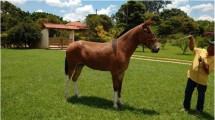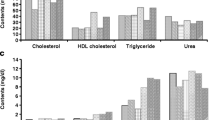Abstract
A cross-sectional study was conducted on the three types of working donkeys in Ethiopia (Abyssinian, Ogaden, and Sennar) while they are in their ecological adaptation sites to evaluate and compare the reference values of serum biochemical profiles. Blood samples were collected from a total of 229 apparently healthy adult working donkeys (134 Abyssinian, 55 Ogaden, 40 Sennar types), and ten serum biochemical analytes (total serum protein, glucose, creatinine, gamma glutamyl transferase (GGT), alanine aminotransferase (ALT), aspartate aminotransferase (AST), alkaline phosphatase (ALP), sodium, chloride, and potassium) were analyzed using a commercial kit (Centronic GmbH, Wartenberg, Germany) for the target groups. A comparison based on the serum biochemical profile of the three donkey types irrespective of sex has shown significantly lower serum activities of ALT (19.20 ± 3.55 IU/l; CI, 18.06–20.34) and AST (178.13 ± 55.70; confidence interval (CI), 160.31–195.94) for Sennar donkeys compared to the activities of ALT (23.65 ± 7.73; CI, 21.56–25.75) and AST (240.60 ± 110.20; CI, 210.81–270.39) (P < 0.05) for Ogaden-type adult donkeys. A significantly lower serum activity of GGT (36.36 ± 14.70 IU/l; CI, 33.85–38.87) was observed for Abyssinian donkeys than for Ogaden donkeys (48.24 ± 16.59 IU/l; CI, 43.75–52.72) (P < 0.001). The serum sodium (147.55 ± 21.81 mmol/l; CI, 141.65–153.44) and chloride (116.67 ± 16.23 mmol/l; CI, 112.28–121.06) concentrations of Ogaden donkeys were found to be significantly higher than the sodium (132.68 ± 14.16 mmol/l; CI, 128.15–137.20) and chloride (104.50 ± 6.45 mmol/l; CI, 102.44–106.56) (P < 0.001) concentrations of Sennar donkeys. A significantly higher serum potassium concentration (4.84 ± 0.63 mmol/l; CI, 4.73–4.94) of Abyssinian donkeys was found compared to those of Sennar (4.38 ± 0.49 mmol/l; CI, 4.22–4.54) and Ogaden donkeys (4.31 ± 0.78 mmol/l; CI, 4.10–4.52) (P < 0.05). There was no significant variation in the serum concentration of total protein, glucose, creatinine, and ALP activity among the three types of donkeys. A comparison of the serum biochemical profile of adult jacks has shown a significantly different result for the serum activities of GGT, ALT, and AST and the concentrations of serum chloride and sodium among the three donkey types. Abyssinian jennies in Afar had significantly higher serum activities of AST (248.92 ± 120.05 IU/l; CI, 202.78–295.07) (P < 0.05) and ALT (29.04 ± 8.34 IU/l; CI, 25.83–32.24) (P < 0.001) than the AST (192.57 ± 66.60 IU/l; CI, 176.97–208.17) and ALT (20.76 ± 6.61 IU/l; CI, 19.21–22.31) activities for jennies in Sebeta but had lower serum glucose and chloride concentrations. In conclusion, the findings of the present study could be used as reference values for the serum biochemical parameters of the three types of donkeys in Ethiopia, and clinical interpretation of the biochemical parameter based on the standard reference values should consider the types of donkeys.
Similar content being viewed by others
References
AL-Busadah KA, Homeida AM (2005) Some physiological variables, biochemical and haematological parameters in Hassawi ass. Sci J King Faisal Univ 6:145–151
Burtis C, Ashwood E (1994) Textbook of clinical chemistry, 2nd edn. Saunders, Philadelphia, pp 1354–1370
Caldin M, Furlanello T, Solano-Gallego L, De Lorenzi D, Carli E, Tasca S, Lubas G (2005) Reference ranges for haematology, biochemical profile and electrophoresis in a single herd of Ragusana donkeys from Sicily (Italy). Comp Clin Path 14:5–12
Coles E (1986) Veterinary clinical pathology, 4th edn. Saunders, Philadelphia, pp 3–325
CSA (Central Statistical Agency) (2008) Agricultural sample survey: report on livestock and livestock characteristics (private peasant holdings), vol 2. Statistical Bulletin. Central Statistical Agency, Addis Ababa, p 188
de Aluja AS, Mondragón VRL, Castillo MDA, Ochoa P (2001) Hematological and biochemical reference values in the donkey (Equus asinus) in Mexico. In: Matthews NS, Taylor TS (eds) Veterinary care of donkeys. International Veterinary Information Service, Ithaca
Dreyfus F (1976) Contribution a l’étude de la zootechnic et de la pathologie des equides domestique en Ethiopie. Thèse pour le doctorat vet. Ecole Nationale Vétérinaire d’Alfort (ENVA), Paris, p 122
French JM, Patrick VH (1995) Reference values for physiological, hematological and biochemical parameters in domestic donkeys (Equus asinus). Equ Vet Edu 7:33–356
Gul ST, Ahmed M, Khan A, Hussain I (2007) Haemato-biochemical observations in apparently healthy equine species. Pakistan Vet J 27:155–158
Hoffman R, Benz JEJ, Shattil SJ (2005) Hematology: basic principles and practice, 4th edn. Churchill Livingston, Philadelphia, p 768
ILRI (International Livestock Research Institute) (2005) Metema pilot learning site diagnosis and program design by IPMS. ILRI, Nairobi, pp 7–12
Jain NC (1993) Essentials of veterinary hematology. Lea & Febiger, Philadelphia, p 417
Manyahilishal EK, Shiferaw TJ, Bojia E, Negussie H (2011) Determination of reference physiological, hematological and serum biochemical values for working donkeys of Ethiopia. Vet Res 4(3):90–94. doi:10.3923/vr.2011.90.94
Piccione G, Assenza A, Costa A et al (2003) Daily rhythm of the body temperature and some hematochemical parameters in donkey. Slov Vet Res 40:69–74
Sevendsen ED (1997) Parasites abroad. In: The professional handbook of the donkey, 3rd edn. Whittet, London
Simenew K, Gezahegne M, Getachew M, Wondyefraw M, Alemayhu L, Eyob I (2011) Reference values of clinically important physiological, hematological and serum biochemical parameters of apparently healthy working equids of Ethiopia. Glob Vet 7(1):01–06
Soldberg HE (1986) Approved recommendation on the theory of reference values. Part 1. The concept of reference values. Clin Chem Acta 165:111–118
Tefera M (2003) Phenotypic and reproductive characteristics of donkeys in Ethiopia. In: Pearson RA, Fielding D, Tabbaa D (eds) Proceedings of the Fourth International Colloquium on Working Equines, Al Baata University, Hama, Syria, 20-26 April 2002. London, UK, SPANA, pp 323–325
Zinkl G, Mae D, Guzman MP (1990) Reference ranges and the influence of age and sex on hematologic and serum biochemical values in donkeys (Equus asinus). Am J Vet Res 51:408–411
Acknowledgments
The authors would like to extend their gratitude to the Department of Biomedical Sciences, Faculty of Veterinary Medicine (AAU, FVM), Addis Ababa University; Donkey Health and Welfare Project (DHWP); German Academic Exchange Service (DAAD), Gendawuha Agricultural Office; Jijiga Regional Veterinary Diagnostic and Research Laboratory; Amibara Woreda pastoralists of the Afar Region; and Tefki and Bole Kebele Developmental Agents of Sebeta Woreda and all their respective local farmers for their great contribution in the proper conduction and accomplishment of the research.
Author information
Authors and Affiliations
Corresponding author
Rights and permissions
About this article
Cite this article
Tesfaye, T., Mamo, G., Endebu, B. et al. Comparative serum biochemical profiles of three types of donkeys in Ethiopia. Comp Clin Pathol 23, 205–212 (2014). https://doi.org/10.1007/s00580-012-1598-z
Received:
Accepted:
Published:
Issue Date:
DOI: https://doi.org/10.1007/s00580-012-1598-z




